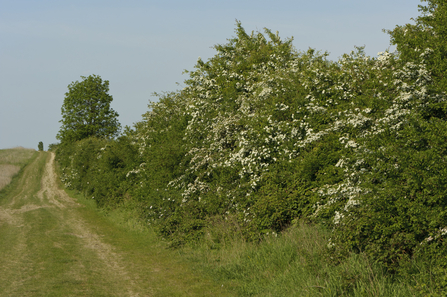
Hawthorn hedge by Chris Gomersall
Hedgerows are one of the most important habitats for wildlife and with correct management will support a good variety of birds, small mammals, insects and plants.
The hedge-margin, if well maintained, will encourage ground-nesting birds such as partridge. It will also be an ideal habitat for many species of insects, which are both food for birds and often predators of pests.
Established hedges
Ideally the hedge should be thick and bushy, as this type is more beneficial to many birds than thin straggly hedges. Hedgerow shrubs such as hawthorn and bramble will provide fruits for food.
Hedges should be cut in winter, ideally in early February. Hedge maintenance should not be done between March and July as birds are nesting, and it is illegal to intentionally damage or destroy the nest of any wild bird. If possible delay maintenance until late autumn, as fruits are valuable food for birds. As fruit is usually borne on last year’s growth it is better to cut hedges every other year. Alternatively, cut one side one year and the other side the next. If possible, allow some trees to develop as standards at about five to10 metre intervals.
Birds can use these as song perches. Ash, oak, field maple and hornbeam are especially good. Oak, in particular, is home to an enormous number of insects.
An A-shaped hedge (see diagram opposite) provides maximum protection for wildlife, but alternative shaping may be needed in different environments. Hedges should be wide enough to shelter and protect birds’ nests.
If the hedge network is extensive, a flail may be the most efficient way to cut. However, the flail should not be used on branches which are more than 2 cm in diameter (about the thickness of your thumb), as this tends to tear branches. Tearing branches may encourage diseases and wounds take longer to heal. It is also important to keep the flail sharp for an effective cut.
Hedge margins
If possible leave a wide undisturbed margin adjacent to the hedge, ideally at least 2m wide. Previously cultivated margins can be left to regenerate naturally or can be sown with a mixture of native grass and wild flower seeds. Pollen and nectar encourage insects, and the plants conceal the base of the hedge which can then provide a home and a run for small mammals. The margins can either have an annual cut in August, after the flowers have seeded, or be cut bi-annually in rotation. This ensures some over-wintering vegetation is always provided. The cuttings should be removed.
Renovating Hedges
If a hedge is very straggly or overgrown, more drastic measures such as coppicing, may be needed. Coppicing involves rejuvenating hedges by cutting down to near ground level. This encourages vigorous regrowth. Coppicing is best done in sections in order to reduce the impact on wildlife. During the winter, cut back the main stem to just above ground level. Cut at an angle to allow the water to run off. In the spring, several shoots will grow up, thus thickening the hedge.
These young shoots may be grazed by deer or rabbits so it may be necessary to protect the shoots with netting or brash until fully established. To thicken the hedge, cut shoots again at the end of the second winter, making the cut at about 45 cms from the base of the shoot.
Elm hedges
Many mature elm trees have died as a result of Dutch elm disease. This disease is carried by the elm bark beetle which burrows beneath the bark of trees which are 10 or more years old. If elm hedges are coppiced in sections on a 15 to 20 year rotation, the growth of vigorous suckers will occur and the disease can be avoided.
Hedge laying
This is a traditional and very effective means of making a fine hedge, but needs skilled training to do effectively. It is best done to improve thin straggly hedges in which individual shoots are 2.5 to 5m in height and about five to 10cms in diameter.
Side branches are cut off the stems. The stems, or pleachers, are then cut almost through at the base, and then bent over to lie horizontally. Stakes, which can be made from the cut side branches, are knocked into the ground at about 2m intervals and the pleachers are woven between them. Side branches grow out of the pleachers and make a dense hedge. Initially it may be necessary to fence with netting to prevent browsing by animals.
Brash
Careful thought should be given to the disposal of the branches removed during coppicing. Brash can sometimes be used to create a barrier to prevent grazing of young hedges. Otherwise it is best to remove it offsite or shred. Burning may well damage other habitats and the wildlife they contain.
New hedges and gapping-up
Gaps often occur in hedges. As a continuous hedge acts as a better wildlife corridor, it is worth ‘gapping up’ by establishing new plants. If the gaps are caused by shade from over-hanging trees, consider planting shade tolerant species like hazel, holly or hawthorn. Further benefits to wildlife can be created by planting new native hedges that link existing hedgerows and semi-natural habitats.
For detailed information on planting new hedges check out our section on hedgerow planting.
